Magento is known for being one of the most powerful and comprehensive systems for launching websites. It provides extensive customization and flexibility and adapts to various needs. But with great power comes even greater need for regular check-ups and maintenance. That’s where the Magento audit tool comes in.
You may find yourself asking the following questions about problems related to your eCommerce website:
- Do all links lead to functional and existing pages?
- Can customers add products to their wish list and access it at a later time?
Today, we are thrilled to present our Magento site audit guide. This guide is designed to ensure that your website provides a stable and seamless user experience. It will prove useful for eCommerce store owners, developers, and Magento enthusiasts who seek information and tools to assess the health of their websites.
Are you ready to make your store future-proof? Yes? Alright, then let’s dive in!
Comprehensive Magento audit: what’s included
Every Magento website audit involves a complex process of identifying issues, evaluating different website components, and finding areas for improvement. Magento audits also examine the website’s code, UI/UX design, speed, security measures, and search engine optimization (SEO).
When auditing your store, you may uncover possible roadblocks along the customer’s purchase journey. Eliminating these roadblocks can improve the overall user experience and boost site efficiency.
There are tons of reasons why you would want to perform an audit for your website. For one, suppose that you want your overall brand to appear higher on search but aren’t sure where to start. Before taking action, you need to review your site’s current health score regarding metadata, keywords, page structure, and content quality. Only then can you begin targeting any of the site’s underperforming parts.
How to start a Magento website audit
Before launching an audit, you’ll need to set clear goals and objectives. For example, if you conduct a code review, it’s recommended to focus on reducing the page load time and simplifying the code. Or, if you evaluate the UI/UX, you may want to reduce the number of abandoned carts. This can be accomplished by introducing a wishlist feature, optimizing call-to-action buttons, or removing unnecessary steps during checkout.
Keep in mind the importance of setting SMART (specific, measurable, achievable, relevant, and time-bound) goals. Avoid vague objectives. For instance, when aiming to increase the repeat customer rate (RCR), set something like this: increase the RCR rate from X to X or by X% within X months.
The next step involves gathering the essential tools and resources, including:
- Website analysis tools: Google Analytics, Google Search Console, or third-party SEO audit tools. These tools allow you to monitor website performance, traffic sources, and search engine visibility.
- Code review tools: Consider using Magento Coding Standards, PHP CodeSniffer, or static code analysis tools. These Magento code audit solutions help evaluate the quality and adherence of the website’s code to the CMS’s coding standards.
- Performance testing tools: Use GTmetrix, Pingdom, or Lighthouse to assess the website’s loading speed, server response time, and performance metrics.
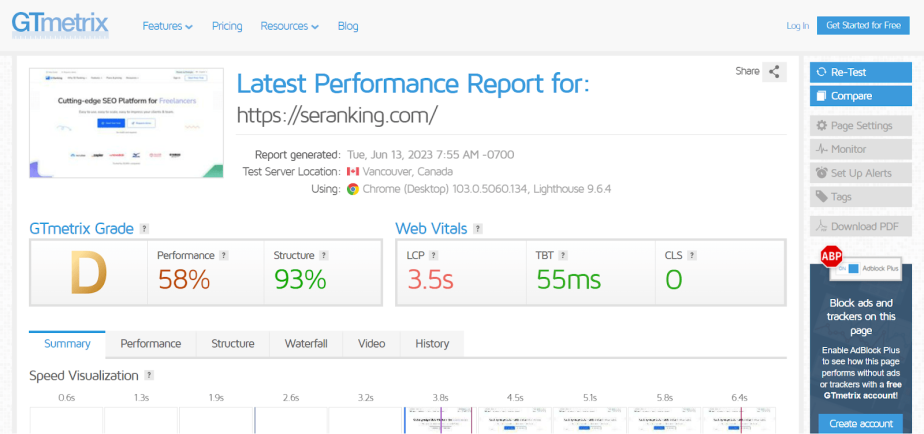
Screenshot taken on the official GTmetrix website
- Security scanning tools: use solutions like Sucuri, MageReport, and OpenVAS to identify potential security vulnerabilities, malware, or outdated software versions.
- Mobile testing tools: With the help of tools like BrowserStack or Responsinator, you can test the website’s responsiveness and compatibility across different devices and screen sizes.
After finding and gathering the most suitable tools for you, create a checklist or roadmap to outline the most critical areas for review.
Use analytics data to assess your strengths and weaknesses
Analytics data plays a crucial role in helping you understand how customers interact with your Magento website. Dive into the reports available in Google Analytics to learn more about the composition of your current traffic. Focus on the following indicators:
- Typical seasonal patterns in your traffic
- Which traffic channels grow or shrink
- How people respond to marketing campaigns
- Pages on your website with the most visitors and engagement.
Pay attention to page load times, bounce rates, conversion rates and all other ecommerce metrics that are relevant to your business.
Magento also integrates with other tools like Hotjar or Kissmetrics, each of which offer heatmaps, session recordings, and customer behavior analysis. This provides you with a comprehensive view of your website’s performance and can assist you with your Magento site audit.
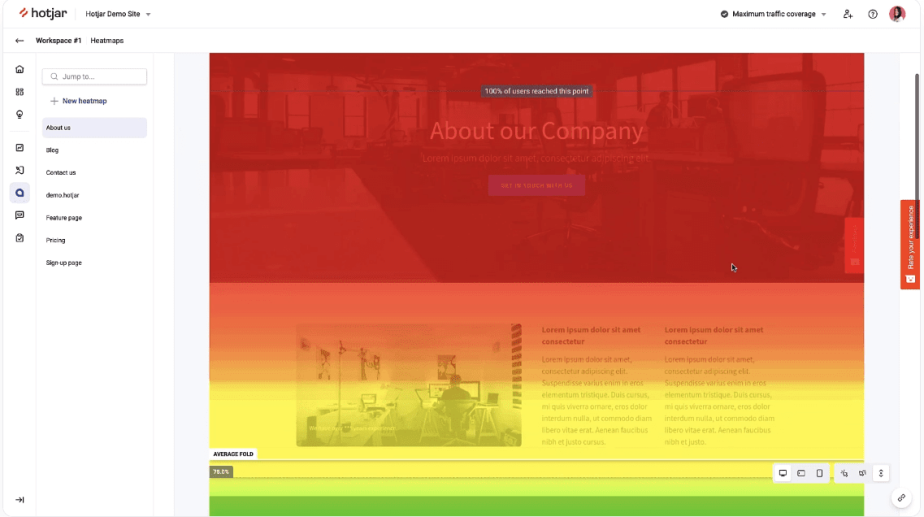
Source: Hotjar
Leverage analytics to examine user navigation paths, clicks, areas where consumers spend more time, and points where they drop off. Any data point that sticks out should prompt you to conduct a thorough audit of the respective areas of your Magento site, whether its’s related to UX or loading speed.
If your analytics reveal that the lion’s share of your traffic comes from organic search, then you absolutely must prioritize conducting a Magento SEO audit.
Magento SEO audit
Ecommerce SEO, just like regular SEO, has many moving parts. It involves performing thorough keyword research, carefully building your site structure, optimizing on-page elements, and developing a tailored link-building strategy.
In this chapter, we’ll address the specific SEO challenges associated with Magento. While Magento is widely recognized as one of the best CMSs for SEO, you may still need to fix the following issues:
- Duplicate pages getting indexed
- Internal search pages getting indexed
- Parameter URLs resulting from faceted navigation
- Slow page loading speed
- Lack of mobile optimization
As you can see, all these issues are primarily technical in nature and necessitate a thorough Magento technical audit. To assist you in the process, we have prepared a technical site audit checklist that you may find useful.
Dedicated tools like SE Ranking’s Website Audit can help you automate the entire auditing process. These tools can quickly pinpoint duplicate pages, spot crawling and indexing errors, and identify site loading issues, among other things.
Also, every detected issue comes with tips on how to fix the problem.
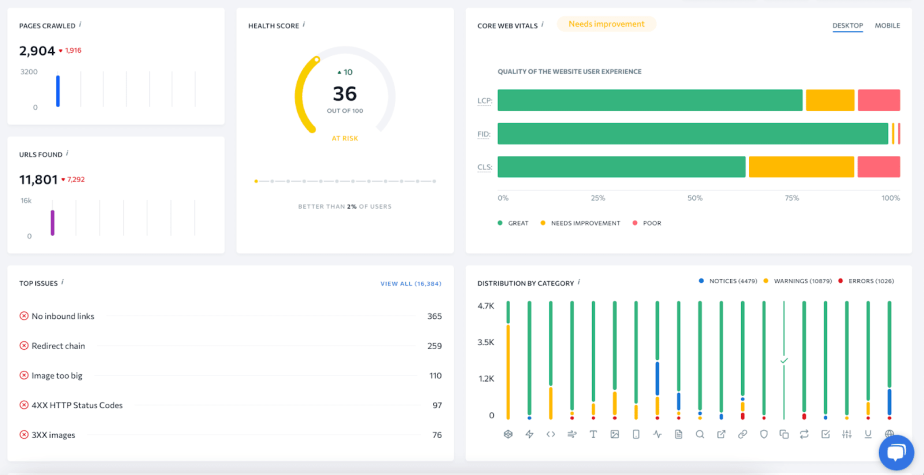
[input widget — Website Audit]
Now, let’s take a detailed look at some of Magento SEO’s biggest issues.
Duplicate pages indexing
Duplicate pages resulting from Magento’s technical weaknesses can have a negative impact on your SEO efforts. Why do they appear, and why are they bad for SEO?
First and foremost, like any other eCommerce platform, Magento can pose certain issues, including the potential generation of duplicate content on your website. This is generally derived from how Magento handles URLs.
For instance, let’s consider a scenario where you have a single product in various sections, such as the “Women” and “Sale” categories. Magento may produce many URLs for this product page, despite the content being the same across all variations. This harms SEO for the following reasons:
- Search engines may perceive pages with identical content as an attempt to manipulate search results, which can lead to penalties for your website.
- Duplicate content can result in “keyword cannibalization,” causing competing pages to vie for rankings in search results and impede their ability to achieve higher positions.
- If you have backlinks leading to duplicate pages, their value will be divided between the two (known as “link equity”). These links would provide greater value to a single page if consolidated.
- Duplicate pages consume the crawl budget allocated by search engines, limiting search bots’ ability to crawl and index other important pages on your site. This can result in unique pages going uncrawled and unindexed.
This is why duplicate content issues on Magento, or on any platform, are so urgent. Preventing them from happening is crucial to boosting your overall SEO effectiveness.
To address duplicate content issues, take the following steps:

- Set up Magento to avoid creating duplicate URLs from the outset.
- Employ canonical tags to specify the preferred page version for search engines.
- Distinguish between user-generated and machine-generated content.
- Opt for a single domain (www vs. non-www links).
- Shield certain pages, such as categories, filters, and search results, from being indexed by Google.
- Review content across multiple stores to identify and address similarities.
- Ensure your site uses HTTPS protocol and properly redirects HTTP traffic.
- Minimize repetitive information.
Internal search pages getting indexed
Another essential aspect of the Magento SEO audit involves addressing your internal search result pages. It’s important to ensure that search engines don’t index them, period. You might wonder why this step is so important. After all, wouldn’t having more indexed pages lead to greater visibility?
The reality is quite different. Here’s why.
When visitors use the on-site search function to look for something, the website generates internal search pages. Normally, these pages are dynamic and change depending on the user’s request. They are not intended for search engines; their purpose is to assist users in navigating your website and discovering the desired information. Here are some concrete reasons why internal search pages shouldn’t be indexed:
- Internal search pages often contain the same products as your category or product pages, resulting in duplicate material, which is damaging to SEO.
- Allowing search engine crawlers to access dynamic search result pages instead of high-quality static content depletes your crawl budget, which is limited.
- Sending users to a search results page from a search engine can spoil the user experience. Instead of providing them with a curated selection of relevant products or a blog post comparing various options, they are confronted with a list of items that may not meet their needs.
Consider a scenario where a customer looks for the “best summer dresses for a beach vacation.”. An internal search page may include products with the tags “dress” and “summer,” requiring users to sort through potentially hundreds of options.
The following steps can help you in preventing these pages from being indexed:
- Add the directive Disallow: /catalogsearch/ to your robots.txt file. By including this directive, search engines will be instructed not to index your site’s catalog search pages during scheduled crawls.
- Use the ‘noindex’ meta robots tag to forbid search engines from crawling your internal search pages, preventing them from appearing in search results. This provides another layer of protection against indexing. Even if search engines come across these pages by following links from third-party sources, they will encounter the ‘noindex’ directive when scanning the page, guiding them not to index the page.
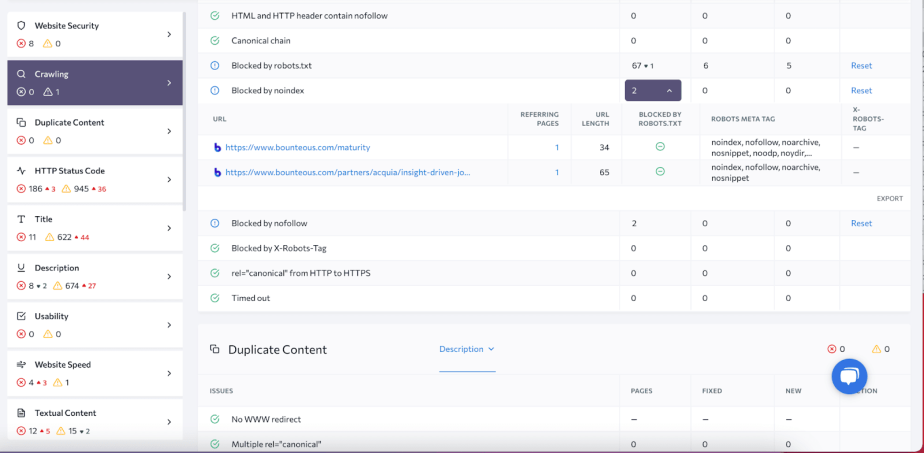
The bottom line? You shouldn’t aim to get all pages indexed. Some pages, like internal search pages, are better off sans indexing, assuming you want better SEO performance and plan to provide a greater overall user experience.
Parameter URLs resulting from faceted navigation
Most eCommerce websites implement faceted navigation, especially sites powered by Magento. This feature lets users filter products based on specific criteria such as color, size, brand, and price range. This functionality enables you to quickly find your desired item, like a blue, medium-sized shirt under $50.
But from an SEO point of view, faceted navigation can pose a major challenge for businesses because each set of filters can produce different URLs with different parameters. For example, in the previous illustration, the URL might be something like www.example.com/shirts?color=blue&size=m&price=50. The more products and filter combinations you have, the more unique URLs the website may generate. This can be overwhelming, especially considering that most of these URLs will point to relatively similar content.
To repeat, faceted navigation can be challenging for SEO for the following reasons:
- Duplicate content
- Crawl budget
- Link equity dilution
Follow the advice below to properly handle parameter URLs:
- Employ canonical tags to specify the primary page version.
- Use a ‘noindex, follow’ robots meta tag on parameter URLs exclude these pages from indexing while still allowing website crawlers to follow the page and find other valuable links.
- Use Google Search Console to specify how particular parameters should be treated. By instructing Google to ignore specific criteria, you can effectively reduce the number of duplicate pages they crawl and index.
- Implement AJAX to ensure the URL remains the same while allowing the page’s content to change depending on the selected filters selected. This minimizes the number of parameter URLs.
Slow page loading speed
Loading speed is a crucial ranking factor that greatly influences visitors’ desire to shop. According to statistics, eCommerce websites that load within one second have 3x better conversion rates than those taking five seconds.
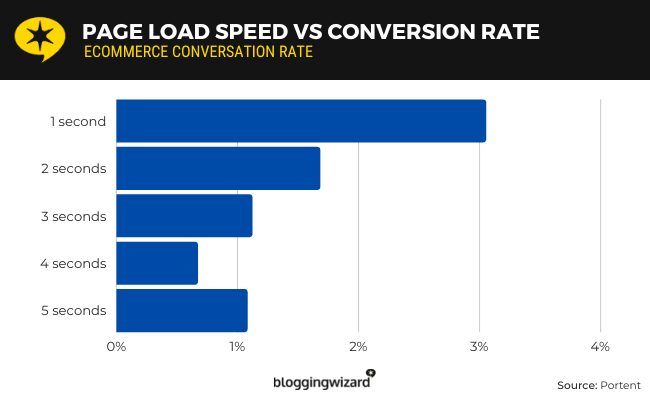
Image credit: Blogging Wizard
When conducting Magento speed optimization, take the following steps:
- Assess the impact of extensions, remove unnecessary ones, and analyze the speed optimization of your theme.
- Review configuration settings like lazy loading for images, implement a flat catalog structure, use Elasticsearch for search results, and optimize cache configuration.
- Optimize backend caching and consider using a full-page cache or Varnish.
- Implement a content delivery network (CDN) if your audience is global. This ensures that your data centers are available in the regions where your visitors come from.
- Analyze CDN speed based on factors like latency, cost-benefit analysis, necessary features, and monitoring tools.
Don’t just consider the overall loading speed but also Core Web Vitals. These metrics measure how quickly the first screen of your page loads and then becomes stable and fully interactive. Core Web Vitals are a part of the larger Page Experience ranking algorithms, designed to reward web pages that provide superior user experience.
Lack of mobile optimization
As the amount of orders made from smartphones continues to rise, your task is to provide an impeccable mobile shopping experience. It goes beyond mere convenience. Users should be able to find the desired product fast and easily, without the need to pinch and zoom a small text or struggle with improperly sized or placed buttons.
Mobile optimization deals with SEO as well. Mobile friendliness is of great importance, and search engines like Google are aware of this. This is why Google indexes content on mobile devices first. In other words, websites with mobile-friendly pages will almost always outperform their unoptimized counterparts.
Without mobile optimization, users may leave your website quickly. This results in higher bounce rates and engagement rates.
Let’s move on to some useful advice for enhancing the mobile version of your website:
- Implement responsive design. This ensures that your website adapts to different devices (desktop, mobile, and tablet) by adjusting layouts, images, and functionalities accordingly.
- Speed up page loading. Since mobile users often access websites on the go, they may also be in places with low Internet connectivity, such as elevators or trains. Uninterrupted work is essential, so it’s up to you to create a seamless experience by incorporating recent technologies into your site. These include progressive web apps, compressed images, leveraged browser caching, and simplified code like CSS and JavaScript, etc. SE Ranking’s Website Audit can help you quickly identify CSS and JavaScript files that can be optimized through compression, caching or minification. Check your page loading speed via Google’s PageSpeed Insights, identify possible issues, and then improve upon them.
- Mind navigation, screen space, and button placement. Since mobile screens are smaller than desktop screens, navigation should be clear and simple for users. This means avoiding any erroneous taps. The same rule applies to all clickable elements, like buttons and links. They should be large and separate enough from one another.
- Leverage tools like Google’s Mobile-Friendly Test to test your site’s mobile-friendliness.
Magento security audit
Magento is one of the most widespread CMSs, making it a lucrative target for hackers. However, dealing with data breach consequences can hurt the business and undermine customer trust. This is why you should conduct a Magento security audit to help you analyze the following security measures:
- Magento security patches and updates. Updates are all about stronger security and performance. For example, Magento 1 has received no support since June 30, 2020. The Magento store is outdated and contains tons of loopholes for criminals to break into the system. This is why you should migrate to M2, which provides maximum protection.
- Vulnerability assessments. Review and update your third-party extensions and ensure PCI compliance.
- Server and database security. Choose a dedicated Magento hosting service, install Security-Enhanced Linux, manage file and folder permissions, and remove any unnecessary server software.
- User permissions. Control permissions to prevent unauthorized access, block unknown users, limit privileges, and whitelist trusted IPs.
Use tools such as Magento Security Scan Tool, MageReport, Magento Malware Scanner, XSSer, and SQLmap to scan your store.
Magento UX audit
Another important aspect of performing a Magento site audit involves the UI/UX review process. This process isn’t just only about making the website more visually appealing, but also about ensuring an easy path from the landing, product, or home page to checkout.
Also, consider that user experience is another important Google ranking factor that determines your Magento site’s SEO performance. Look into Core Web Vitals statistics to see the correlation between your design and SEO.
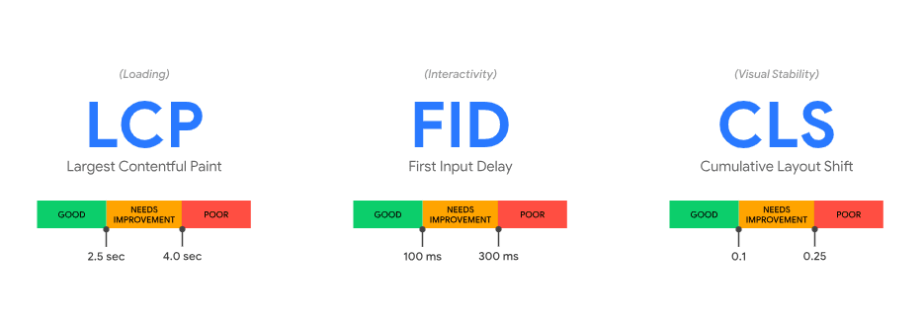
Image credit: Google Developers
Here are some steps for conducting a comprehensive Magento UX audit, which paves the way to optimizing your store’s user experience and boosting its overall performance:
- Ask visitors to complete tasks. These tasks include finding a product, delivery terms, or buying a present. Analyze any behavior and navigation issues, such as time spent and steps required to complete the desired action.
- Evaluate your key pages. These include the homepage, contact us, delivery, warranty, about us, and product pages. Each of these pages should clearly describe your company, products, purpose, customer reviews, etc.
- Go through the content. This includes images, videos, text descriptions, links, etc. How do visitors interact with it? Does anything require improvement?
- Make sure the website is accessible to everyone. This includes individuals with various health requirements. Simply adjust fonts, ALT tags, colors, and buttons to make the experience more convenient.
Magento code audit
Removing bugs will help the website function more effectively and prevent people from leaving. And that is because, if we were to be honest, consumers won’t stay on a broken website. Bugs can do major harm to your website metrics and lead to it taking lower positions in search results.
To prevent this from happening, you must carefully analyze all Magento features and extensions. Whether it’s product attributes, payment gateways, or shipping methods, examine each aspect closely to ensure a smooth user experience. That means no hiccups. Track and document all the bugs, as well as the steps you must take to remove them, during your Magento code audit. Focus more on critically important areas from product discovery to the purchase process.
When debugging in Magento, it’s important to consider any added complexity introduced by the modular architecture. Potential conflicts may arise due to customizations or between extensions. Thankfully, Magento offers built-in debugging tools such as logging and exception reporting, which are effective for error resolution.
Don’t stop monitoring
Monitoring is an ongoing process meant to ensure that the online store remains stable. During monitoring, ask yourself these questions:
- How does your page load time compare to that of your competitors?
- Are there any new security patches for protecting payments?
Perform a Magento website audit once in a while to answer them.
Establish a regular schedule. For example, a small online store with fewer products and less frequent updates could typically afford to perform a Magento website audit annually or every 6 to 12 months. In comparison, larger businesses should audit their website once every 3 to 9 months.
Also, remember that unforeseen events can happen, which is why it’s important to have a backup plan. Save your database and files and keep them in a safe place so you can swiftly recover from any system failures or security breaches.
Final Word
Performing a Magento site audit is integral to running an online store. New updates are always coming, consumer behaviors change, and competition will always loom over your shoulder. Each of these factors require that your store rapidly adapts to changing user needs and expectations, and encourages and inspires them to buy your products.
Finally, here is a quick list of the different parts of your website that you should analyze:
- Magento code audit
- Magento technical audit
- Magento security audit
- Magento SEO audit
That’s it! Be sure to implement the tips we provided here to eliminate any issues before they pile up and become too hard to handle.
